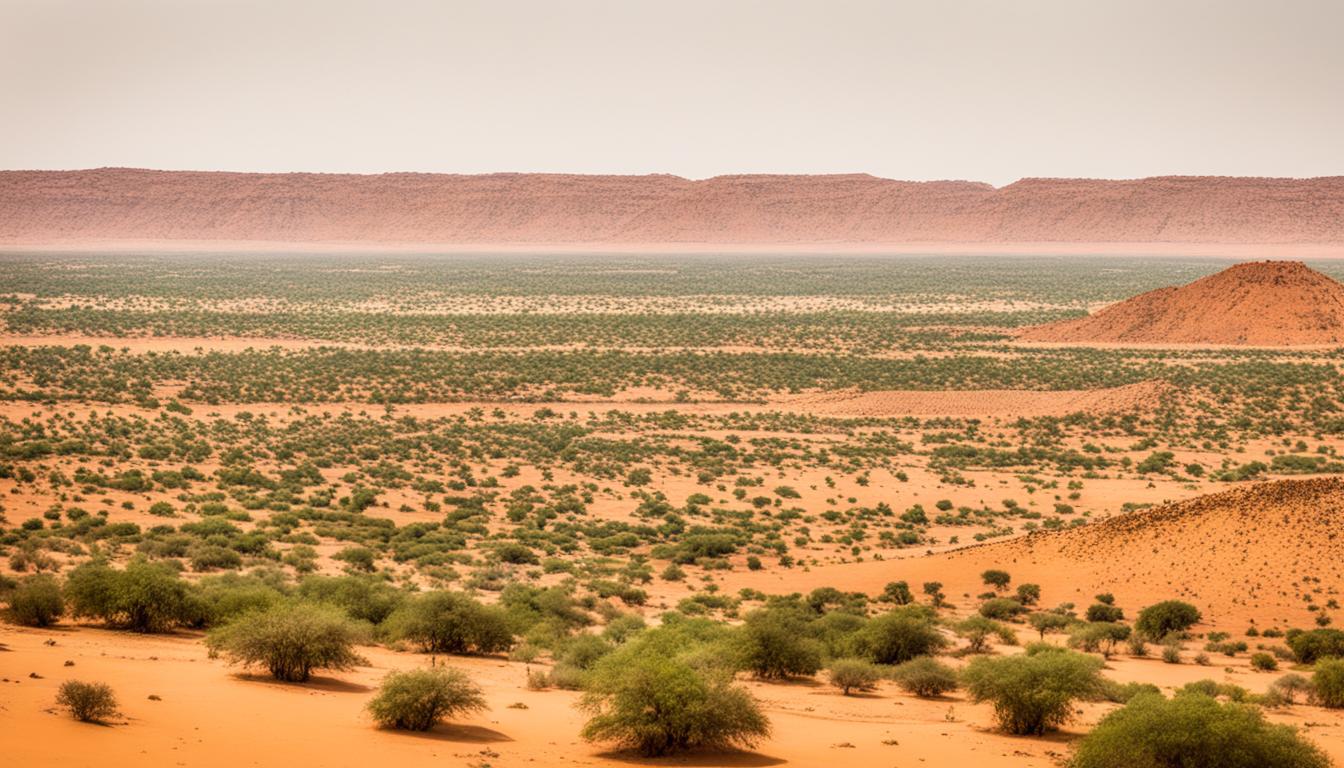Qatar Sacred Natural Sites and Biodiversity
Did you know that Qatar is home to a fascinating array of flora and fauna? With over 1,955 species, including 955 marine species, Qatar boasts a remarkable biodiversity that captivates both scientists and nature enthusiasts alike. From mammals and reptiles to avian species and terrestrial invertebrates, the country’s diverse ecosystem is a testament to its commitment to conservation efforts and natural heritage preservation.
Key Takeaways
- Qatar is home to 1,955 species of flora and fauna, including 955 marine species.
- Conservation efforts in Qatar are focused on protecting and preserving the country’s unique natural heritage.
- Natural sites in Qatar have significant cultural and religious associations.
- The Sidra tree is a symbol of strength and prosperity in Qatari culture.
- Indigenous conservation practices play a crucial role in preserving Qatar’s natural sites and biodiversity.
The Cultural Significance of Qatar’s Natural Sites
Natural sites in Qatar hold deep cultural significance and are often considered symbols of strength, endurance, and prosperity. These sites embody the rich historical and religious associations of the region, connecting the people of Qatar to their past and shaping their present identity. One such site that exemplifies the cultural significance of Qatar’s natural heritage is the Sidra tree, which is highly valued in Qatari culture for its symbolic representation.
“The Sidra tree has always played a central role in our culture. Its remarkable ability to withstand the harsh desert conditions has long been seen as a metaphor for the resilience of our people. It represents our connection to the land, our values of strength, and the promise of prosperity. The Sidra tree is a living testament to our heritage,” says Sheikh Qasim Al Thani, a renowned conservationist in Qatar.
Indigenous conservation practices in Qatar play a crucial role in protecting and preserving the cultural heritage associated with these natural sites. Passed down through generations, these practices reflect the deep-rooted knowledge and respect for the environment that has been ingrained in Qatari society for centuries. These practices focus on sustainable land management, promoting biodiversity, and maintaining a delicate balance between human activities and the natural environment.
By enshrining the cultural significance of natural sites and engaging in indigenous conservation practices, Qatar not only safeguards its heritage but also creates a harmonious coexistence between humans and nature.
Preserving the Sidra Tree: A Testament to Cultural Identity
The Sidra tree, scientifically known as Ziziphus spina-christi, is an iconic symbol of Qatari culture. Revered for its resilience in the face of adversity, the Sidra tree stands tall as a representation of strength and determination. It holds a special place in folklore, art, and literature, symbolizing the enduring spirit of the Qatari people.
Efforts to protect and preserve the Sidra tree contribute to the overall conservation of Qatar’s natural heritage. Through reforestation projects, education, and awareness campaigns, Qatar ensures that future generations understand and appreciate the cultural significance of this remarkable tree.
Preserving the Cultural Heritage of Qatar’s Natural Sites
| Conservation Practices | Description |
|---|---|
| Sustainable Land Management | Indigenous communities in Qatar employ sustainable land management practices to protect natural sites from degradation caused by human activities while ensuring the preservation of cultural significance. |
| Biodiversity Protection | Conservation efforts focus on preserving the diverse range of species and habitats found within natural sites, recognizing their crucial role in maintaining the balance of ecosystems and safeguarding cultural heritage. |
| Engagement with Indigenous Communities | Collaboration with indigenous communities ensures the incorporation of traditional knowledge and practices in conservation efforts, promoting a holistic approach to preserving the cultural significance of natural sites. |
| Educational Programs | Education and awareness programs play a vital role in instilling a sense of pride and ownership among local communities, fostering a deeper understanding of the cultural connections to natural sites. |
By embracing the cultural significance of natural sites and implementing indigenous conservation practices, Qatar showcases its commitment to protecting its heritage, promoting sustainable practices, and nurturing a harmonious relationship between culture and nature.
The Environmental Impact of Qatar’s Biodiversity
Qatar’s biodiversity plays a crucial role in maintaining the delicate balance of its environment. With a wide variety of species, from vibrant marine life to unique flora and fauna, the ecosystems in Qatar thrive and flourish.
One remarkable example of the environmental impact of Qatar’s biodiversity is the Sidra tree. This majestic tree species not only adds beauty to the landscape, but it also serves as a natural solution to prevent soil erosion and desertification in arid regions.

The Sidra tree’s extensive root system helps stabilize the soil, preventing wind and water erosion. Its ability to flourish in harsh desert conditions showcases its role as a protector of Qatar’s fragile natural environment.
In addition to the Sidra tree, Qatar is home to various wildlife sanctuaries and protected areas. These sanctuaries serve as havens for diverse species of animals and plants, safeguarding their habitats and contributing to the overall conservation of Qatar’s biodiversity.
By preserving these protected areas, Qatar ensures the sustainability of its natural environment for generations to come. It is through these efforts that Qatar fulfills its commitment to environmental sustainability and the protection of its rich biodiversity.
As visitors explore the wildlife sanctuaries, they witness firsthand the intricate web of life that relies on the harmonious coexistence of different species. From vibrant birdlife to elusive reptiles, Qatar’s biodiversity captivates and inspires.
Furthermore, the preservation of wildlife sanctuaries not only benefits the local environment but also contributes to global conservation efforts. Protecting and sustaining these precious ecosystems helps maintain a delicate equilibrium and safeguards endangered species, making Qatar an essential partner in international biodiversity protection.
The Importance of Environmental Sustainability in Qatar
Environmental sustainability is a top priority for Qatar, as the country recognizes that a healthy and balanced environment is vital for the well-being of current and future generations. Qatar’s commitment to protecting its biodiversity extends beyond its borders, with initiatives aimed at promoting sustainable practices and raising awareness of the importance of nature preservation.
By combining efforts in wildlife sanctuary management, biodiversity conservation, and environmental education, Qatar aspires to create a sustainable future where humans and nature coexist harmoniously. Through these collective endeavors, Qatar strives to pave the way for a greener, more environmentally conscious world.
Conservation Efforts in Qatar
Qatar is dedicated to the protection and preservation of its natural heritage, with a particular focus on biodiversity. The Supreme Council for the Environment and Natural Reserves (SCENR) takes charge of wildlife conservation initiatives in the country. Through various conservation efforts, Qatar aims to safeguard its unique ecosystems and promote sustainable practices for the long-term protection of both the environment and its biodiversity.
One of the key components of Qatar’s conservation strategy is the implementation of reforestation projects. By working towards restoring and expanding green areas, Qatar seeks to enhance habitats for plant and animal species, fostering biodiversity. These initiatives promote the growth of native flora and contribute to the overall health and balance of the ecosystems within the country. Through strategic planting and management, Qatar’s conservation efforts positively impact the protection of its diverse range of wildlife.
Raising public awareness about the importance of biodiversity is another aspect of Qatar’s conservation efforts. Public awareness campaigns play a vital role in educating and engaging the community in biodiversity protection and promoting sustainable behaviors. By empowering individuals with knowledge and understanding, Qatar encourages active participation in the preservation of natural habitats and the responsible use of resources.
“Conservation is a shared responsibility that requires collective action. Together, we can make a difference in preserving and protecting Qatar’s natural heritage for future generations.” – SCENR spokesperson
Wildlife Sanctuaries and Protected Areas
Qatar has established several wildlife sanctuaries and protected areas to ensure the conservation of its unique biodiversity. These regions act as safe havens for vulnerable species, offering them protection and a nurturing environment. The designation of these areas as protected zones helps maintain critical habitats while promoting sustainable land management practices. Qatar’s commitment to biodiversity protection is epitomized in these protected areas as they provide essential corridors and breeding grounds for a diverse range of flora and fauna.
| Protected Area | Location | Main Focus |
|---|---|---|
| Al Reem Reserve | South of Doha | Conservation of desert ecosystems and Arabian oryx |
| Mesaieed Protected Area | South of Doha | Preservation of coastal habitats and migratory birds |
| Khor Al-Adaid Reserve | Southeast coast | Protection of the unique ecosystems, including the inland sea and surrounding habitats |
These protected areas not only serve as a refuge for wildlife but also offer opportunities for visitors to experience and appreciate Qatar’s natural beauty. Responsible eco-tourism allows individuals to connect with nature, fostering a deeper understanding and appreciation for the importance of biodiversity conservation.
The National Biodiversity Strategy and Action Plan serve as a comprehensive framework for biodiversity management in Qatar. This strategic document outlines a series of priority actions, including the protection of natural habitats and species, the sustainable use of resources, and the integration of biodiversity considerations into development plans and policies. By implementing this strategy, Qatar aims to achieve its conservation goals and ensure a sustainable future for its natural heritage.
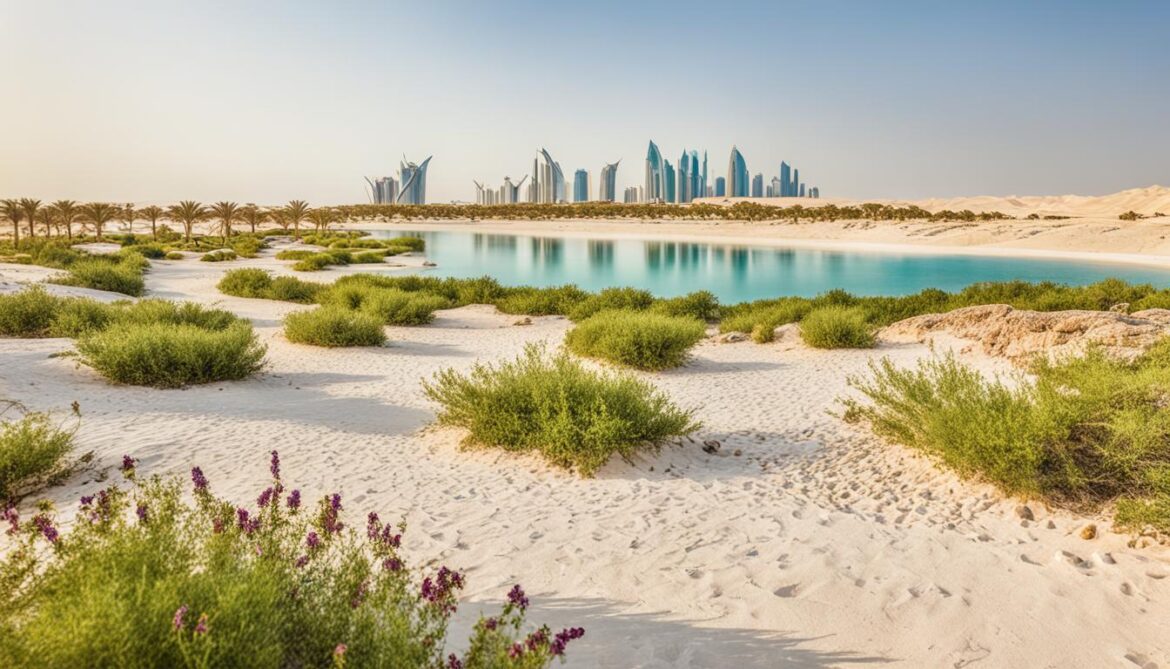
The Sidra Tree: A Botanical Marvel
The Sidra tree, scientifically known as Ziziphus spina-christi, is a unique tree native to various regions in Africa and the Middle East. This extraordinary tree is highly revered in Qatar due to its resilience and ability to thrive in arid environments. The Sidra tree’s cultural significance goes beyond its botanical properties and is deeply rooted in Qatari traditions and beliefs.
“The Sidra tree has always represented strength and prosperity in our culture. Its ability to withstand harsh conditions symbolizes the resilience and determination of the Qatari people.” – Sheikh Abdulaziz Bin Ali Al-Thani
Efforts to protect and preserve the Sidra tree align with Qatar’s conservation initiatives, ensuring the safeguarding of its natural heritage. With its spiritual and cultural value, the Sidra tree plays a significant role in the country’s biodiversity preservation and environmental sustainability.
The Sidra tree’s adaptation to the arid environment showcases its remarkable ability to survive in challenging conditions. Its deep root system allows it to access water sources deep underground, making it well-suited for desert landscapes. This adaptability makes the Sidra tree a symbol of endurance in Qatar’s challenging climate.
A Symbol of Strength and Prosperity
The Sidra tree holds immense cultural importance in Qatar, often referred to as the ‘Tree of Life.’ It has been an integral part of Qatari traditions and rituals for centuries. The tree’s wide spreading branches provide shade for gatherings, while its fruit serves as a source of sustenance for both humans and wildlife.
In addition to its cultural significance, the Sidra tree offers various ecological benefits. Its presence in the arid landscape helps prevent soil erosion and desertification, promoting environmental sustainability in Qatar. The tree’s ability to retain moisture in the soil contributes to the overall health and stability of the ecosystem, making it an essential component of Qatar’s natural heritage.
Conservation of Qatar’s Natural Heritage
Efforts to protect and preserve the Sidra tree are an integral part of Qatar’s broader conservation initiatives. The conservation of the Sidra tree not only ensures the preservation of a unique botanical species but also contributes to the conservation of Qatar’s sacred natural sites and biodiversity.
Conservation efforts in Qatar, such as reforestation projects and sustainable land management practices, aim to create a conducive environment for the growth and proliferation of the Sidra tree. These initiatives are essential for maintaining the ecological balance of Qatar’s natural ecosystems and preserving its rich natural heritage.
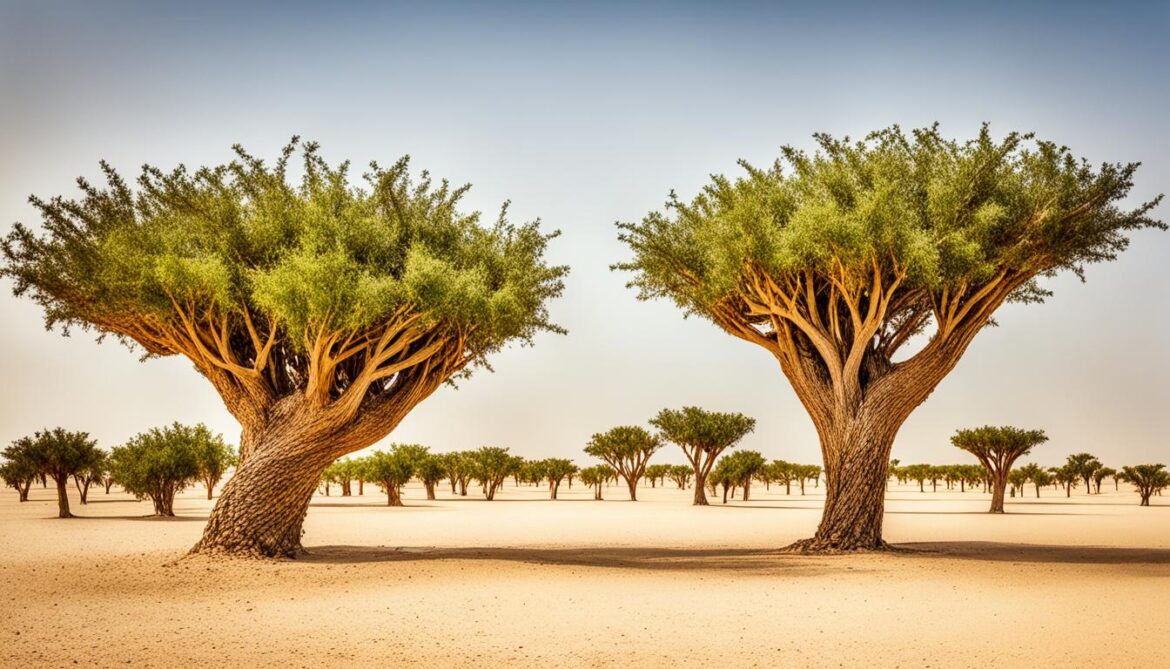
Qatar’s commitment to the conservation of the Sidra tree and its natural heritage extends beyond national borders. The country’s efforts to protect and preserve the Sidra tree have gained recognition globally, reinforcing its dedication to environmental sustainability and biodiversity preservation.
By safeguarding the Sidra tree, Qatar is not only ensuring the survival of a remarkable botanical species but also upholding its cultural traditions and protecting the natural heritage that makes the country truly unique.
The Role of Sidra Tree in Environmental Sustainability
The Sidra tree plays a crucial role in contributing to environmental sustainability in Qatar. With its remarkable ability to thrive in arid regions, this majestic tree offers various benefits that are vital for preserving the country’s natural heritage.
One significant contribution of the Sidra tree is its role in preventing soil erosion and desertification. The deep roots of the Sidra tree penetrate the soil, firmly anchoring it and preventing wind and water erosion. This natural mechanism helps maintain the integrity of Qatar’s delicate ecosystems and preserves the fertile topsoil that is essential for supporting plant growth.
Furthermore, the Sidra tree’s fruits serve as a valuable source of sustenance for wildlife in the region. The abundant fruits attract a diverse range of animals, including birds and mammals, promoting biodiversity and strengthening the overall ecosystems. This intricate web of interactions contributes to the resilience and stability of Qatar’s natural environment.
“The Sidra tree’s ability to grow in arid regions, prevent soil erosion, and provide sustenance for wildlife showcases its significant role in enhancing environmental sustainability in Qatar.”
The Qatar government recognizes the importance of the Sidra tree and has implemented various conservation initiatives to preserve this botanical marvel. These efforts include reforestation projects, ensuring the propagation and growth of the Sidra tree in protected areas and natural reserves throughout the country.
By safeguarding the Sidra tree, Qatar upholds its commitment to environmental sustainability and the preservation of its natural heritage. The Sidra tree’s resilience, its ability to stabilize soil, and its contribution to biodiversity make it a symbolic and vital component of Qatar’s delicate ecosystems.
Benefits of the Sidra Tree for Environmental Sustainability
| Benefits | Description |
|---|---|
| Prevents soil erosion | The deep roots of the Sidra tree stabilize the soil, protecting it from wind and water erosion. |
| Preserves fertile topsoil | The prevention of soil erosion helps maintain the integrity of Qatar’s delicate ecosystems by preserving the fertile topsoil necessary for plant growth. |
| Enhances biodiversity | The Sidra tree’s abundant fruits provide sustenance for a diverse range of wildlife, contributing to the overall biodiversity of the region. |
The Sidra tree’s multifaceted contributions to environmental sustainability highlight the intricate balance between natural resources and human activities in Qatar. By recognizing and protecting the invaluable role of the Sidra tree, Qatar ensures the long-term preservation of its natural heritage for future generations to cherish and enjoy.
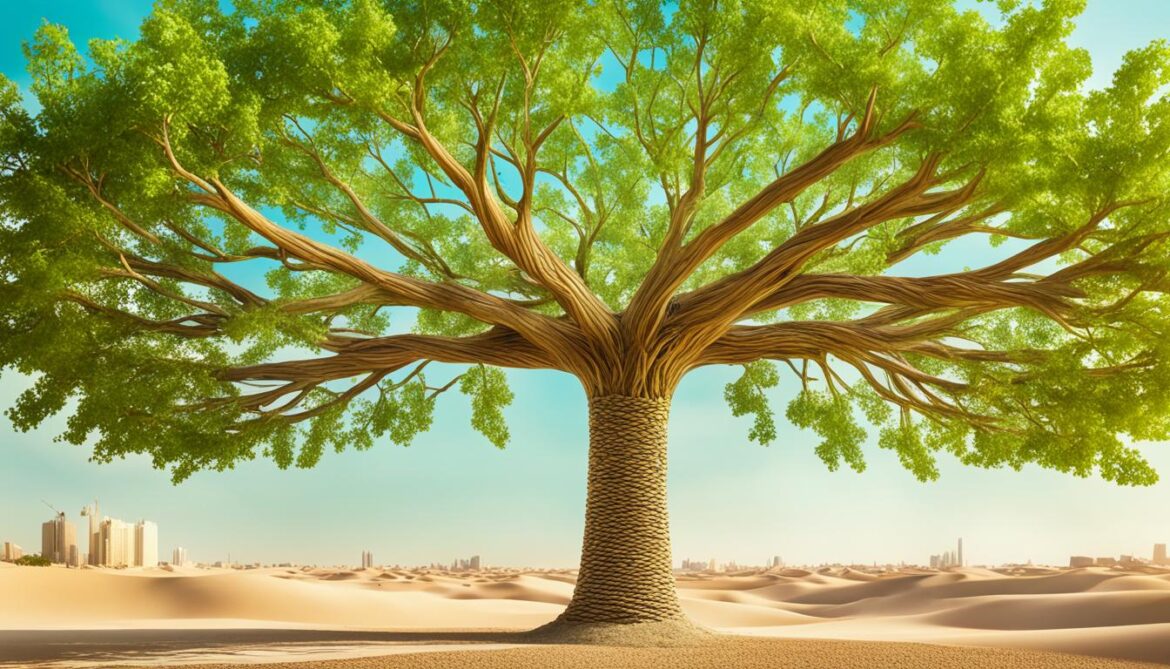
Qatar’s Efforts in Reforestation and Land Management
As part of its commitment to conservation efforts and biodiversity protection, Qatar is actively engaged in reforestation projects and sustainable land management practices. These initiatives aim to restore and preserve natural habitats, protect native species, and ensure the long-term sustainability of Qatar’s natural heritage.
Reforestation projects play a vital role in restoring natural ecosystems and enhancing biodiversity. Native tree species, including the iconic Sidra tree, are planted to revitalize the landscape and create a conducive environment for a diverse range of flora and fauna. By replanting indigenous tree species, such as the Sidra tree, Qatar is not only preserving its natural heritage but also providing essential habitats for wildlife.
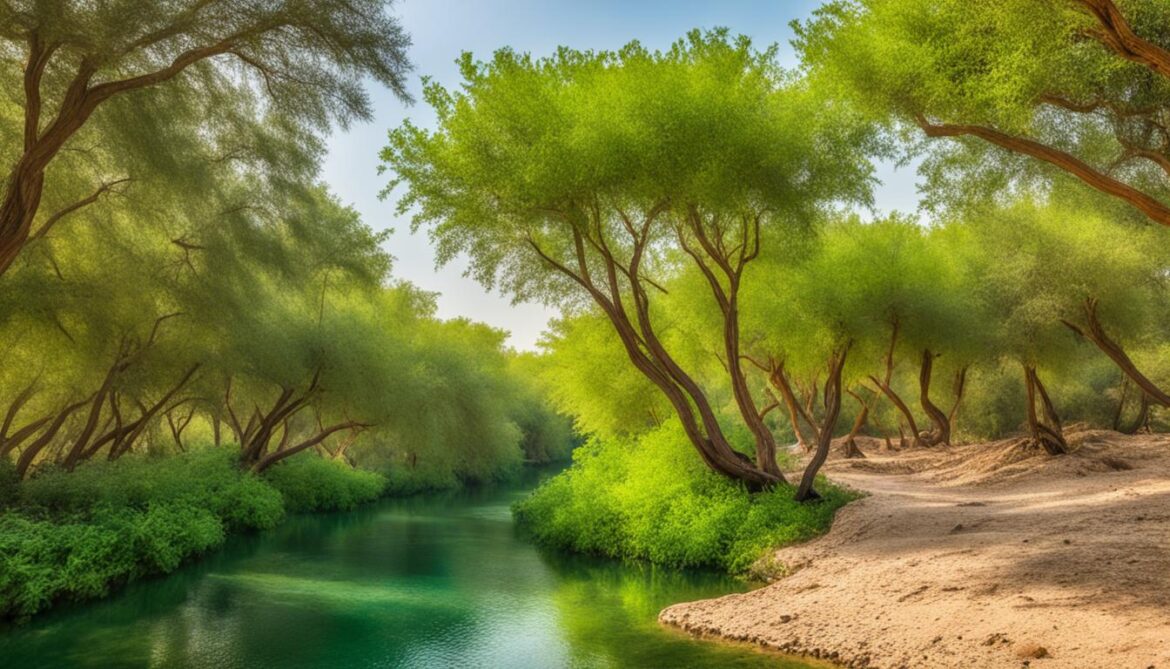
Land management practices in Qatar prioritize sustainable approaches. Through effective land use planning and careful resource management, Qatar aims to mitigate the impact of human activities on the environment. By implementing sustainable land management practices, Qatar strikes a balance between developmental objectives and the preservation of natural ecosystems.
These conservation efforts also extend to protecting and restoring fragile coastal ecosystems. Coastal areas play a critical role in supporting Qatar’s biodiversity, and efforts are underway to protect mangroves, seagrass beds, and coral reefs. By safeguarding these coastal habitats, Qatar ensures the sustainable functioning of marine ecosystems and the protection of essential marine species.
The collaborative efforts of both government institutions and local communities are essential in achieving successful reforestation and land management practices. It is through the collective commitment to natural heritage preservation that Qatar can continue to protect its unique biodiversity and ensure a sustainable future for generations to come.
Eco-Friendly Tourism in Qatar
Qatar’s natural sites and biodiversity offer a captivating experience for eco-friendly tourists. With its diverse landscapes, cultural sites, and wildlife sanctuaries, Qatar provides an ideal destination for those seeking sustainable tourism practices. Visitors can explore the breathtaking natural beauty while ensuring the conservation of the country’s unique natural heritage.
Eco-tourism in Qatar not only allows travellers to immerse themselves in the magnificence of the surroundings but also encourages them to understand and appreciate the cultural significance of these sites. The combination of rich biodiversity and cultural heritage creates an unforgettable journey, enabling visitors to connect with Qatar’s past, present, and future.
By participating in eco-friendly activities such as guided wildlife tours, responsible camping, and nature walks, tourists can contribute to the preservation of Qatar’s natural sites. These sustainable practices prioritize environmental conservation, ensuring that future generations can continue to enjoy the splendour of these unique landscapes.
When exploring Qatar, consider visiting culturally significant natural sites such as the Al Zubarah Archaeological Site, which has been recognized as a UNESCO World Heritage Site. This remarkable destination encapsulates the historical and cultural heritage of Qatar, allowing visitors to witness its biodiversity protection efforts firsthand.
Embarking on an eco-friendly tour in Qatar not only provides an unforgettable experience but also supports the country’s commitment to preserving its natural heritage. By embracing sustainable practices, visitors can become ambassadors for the conservation of Qatar’s natural sites and encourage others to appreciate their cultural significance.
Indigenous Conservation Practices in Qatar
Indigenous conservation practices in Qatar have been passed down through generations and play a vital role in preserving the natural heritage and cultural significance of the country’s sacred natural sites. These practices embody a deep respect for the environment and a commitment to maintaining the delicate balance between human activities and the natural world.
One of the key aspects of indigenous conservation practices is sustainable land management. Local communities have developed techniques to ensure the responsible use of natural resources while minimizing environmental impact. This includes practices such as rotational grazing, where livestock are moved periodically to prevent overgrazing and maintain the health of the ecosystem.
The protection of wildlife is another crucial aspect of indigenous conservation practices. Traditional knowledge and beliefs have led to the establishment of protected areas and wildlife sanctuaries, where native species can thrive undisturbed. These areas not only serve as vital habitats but also act as cultural repositories, providing a connection between the local communities and their ancestral lands.
Indigenous conservation practices also recognize the cultural significance of natural sites in Qatar. These sites are often considered sacred and hold deep historical and religious associations. The indigenous communities have implemented measures to ensure the preservation of these sites, such as regulating access and conducting regular rituals and ceremonies to pay homage to their spiritual importance.
“Our connection to the land and its creatures is at the heart of our indigenous conservation practices. We believe that by protecting and caring for the natural world, we are preserving our cultural heritage for future generations.” – Rashid Al-Marri, Indigenous Conservationist
In recognition of the cultural significance of natural sites, indigenous communities in Qatar actively participate in decision-making processes related to conservation efforts. Their traditional knowledge and insights are invaluable in shaping policies and programs that align with cultural values and ensure the long-term preservation of significant natural sites.
Example of Indigenous Conservation Practice: Al Zubarah Archaeological Site
One notable example of the cultural significance of natural sites in Qatar is the Al Zubarah Archaeological Site. This UNESCO World Heritage Site holds immense historical and archaeological value and serves as a testament to Qatar’s rich cultural heritage. Indigenous conservation practices have played a crucial role in the preservation and restoration of this site, ensuring that future generations can appreciate and learn from its significance.
| Indigenous Conservation Practices in Qatar | Cultural Significance |
|---|---|
| Sustainable land management | Preserving ancestral lands |
| Protection of wildlife | Connecting communities to their natural environment |
| Preservation of sacred natural sites | Sustaining cultural identity |
Indigenous conservation practices in Qatar are a testament to the deep-rooted connection between culture and the natural world. By integrating traditional knowledge and beliefs with modern conservation efforts, Qatar is fostering a sustainable future that respects both its natural heritage and cultural significance.
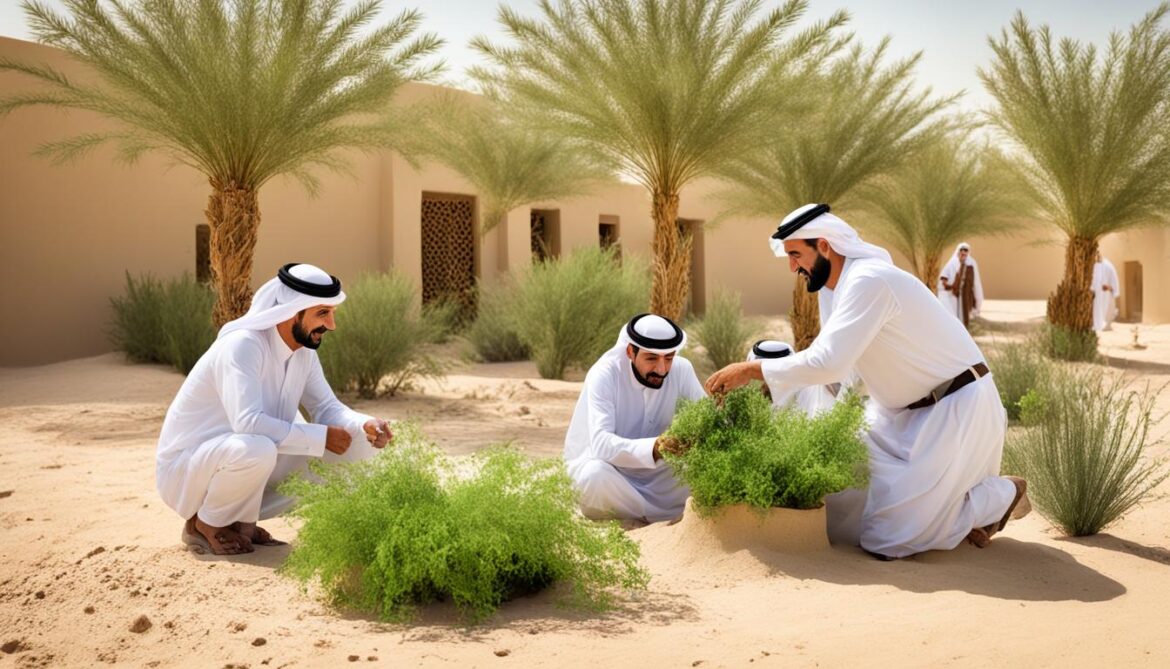
Qatar’s Commitment to Conservation and Biodiversity Protection
Qatar is deeply committed to the conservation and protection of its unique natural heritage. Through the establishment of protected areas, initiatives for wildlife conservation, and the development of a National Biodiversity Strategy and Action Plan, Qatar aims to safeguard its rich biodiversity and promote sustainable use of resources.
One of the key conservation efforts in Qatar is the establishment of protected areas. These areas serve as safe havens for diverse species of flora and fauna, allowing them to thrive and maintain healthy populations. By designating specific zones for biodiversity protection, Qatar ensures the preservation of its natural ecosystems.
In addition to establishing protected areas, Qatar has implemented various initiatives for wildlife conservation. These initiatives involve research, monitoring, and habitat restoration, contributing to the overall conservation and protection of endangered species. Qatar’s conservation efforts also include raising awareness about the importance of biodiversity and the need for its protection.
The development of a National Biodiversity Strategy and Action Plan further exemplifies Qatar’s commitment to conservation. This comprehensive framework sets out strategic goals and action plans to ensure the sustainable management of Qatar’s natural resources and biodiversity. The plan focuses on preserving ecosystems, promoting sustainable land use practices, and safeguarding the long-term health and abundance of Qatar’s natural habitats.
By prioritizing conservation and biodiversity protection, Qatar demonstrates its dedication to sustainability and environmental stewardship. These efforts not only contribute to the preservation of Qatar’s natural heritage but also promote global awareness and understanding of the importance of biodiversity conservation.
| Conservation Efforts | Biodiversity Protection |
|---|---|
| Establishment of protected areas | Preservation of natural ecosystems |
| Initiatives for wildlife conservation | Protection of endangered species |
| Development of National Biodiversity Strategy and Action Plan | Sustainable management of natural resources |

Qatar’s Sacred Natural Sites and Global Recognition
Qatar’s commitment to preserving its sacred natural sites and biodiversity has garnered global recognition. As a testament to its efforts, several of Qatar’s natural sites have been inscribed on UNESCO’s World Heritage List, further highlighting the country’s dedication to conservation and the preservation of its natural heritage.
“The inclusion of Al Zubarah Archaeological Site in Qatar showcases the historical and cultural significance of the country’s heritage, while also emphasizing the importance of biodiversity conservation and preservation efforts.”
Being inscribed on the World Heritage List not only signifies the outstanding universal value of these sites but also serves as a platform to raise awareness about the significance of biodiversity protection. It underscores Qatar’s role in safeguarding its natural heritage and contributes to the global recognition of its conservation efforts.
Qatar’s sacred natural sites, with their rich biodiversity and cultural value, serve as a testament to the country’s commitment to environmental sustainability and the preservation of its natural heritage. By upholding these sanctuaries, Qatar showcases its determination to protect and promote its sacred sites, creating a lasting legacy for future generations.
Conclusion
Qatar’s sacred natural sites and biodiversity are of immense cultural and environmental importance. These unique ecosystems and cultural heritage must be protected and preserved through both indigenous conservation practices and institutional efforts.
Qatar’s commitment to conservation is demonstrated through sustainable land management, reforestation projects, and the promotion of eco-friendly tourism. These conservation efforts ensure the long-term sustainability and appreciation of Qatar’s natural heritage.
By safeguarding its sacred natural sites and biodiversity, Qatar not only preserves its own cultural identity but also contributes to global efforts in natural heritage preservation. Qatar’s dedication to conservation serves as an inspiration for other nations to protect and appreciate their own natural treasures.






